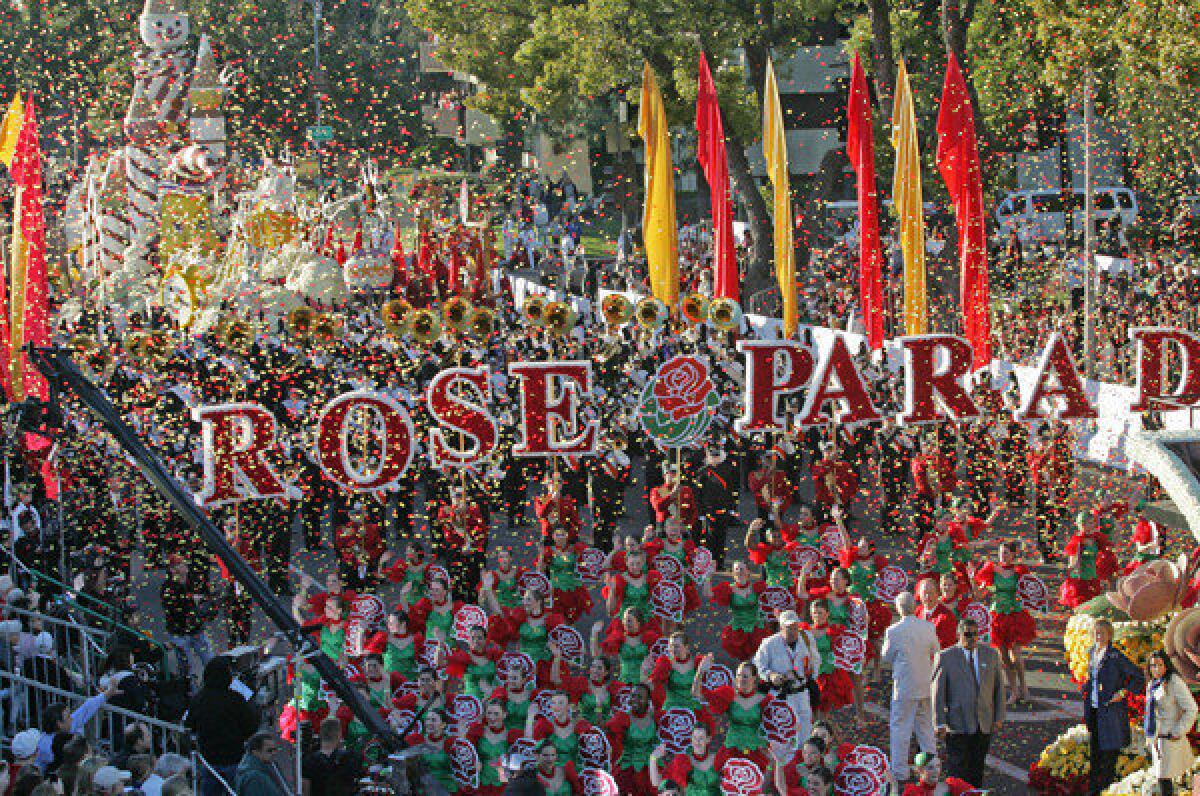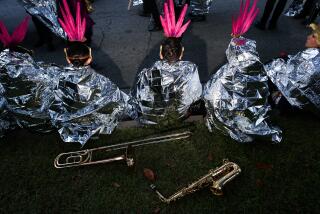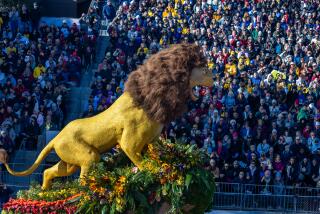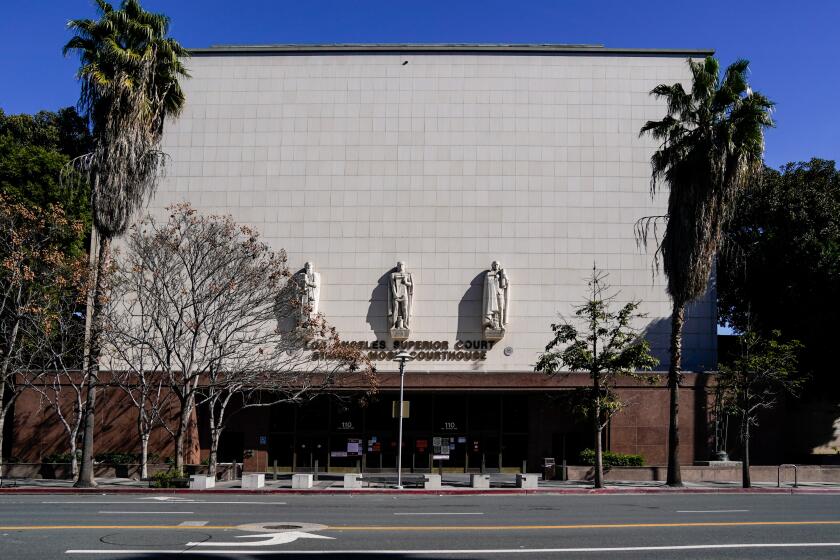The Rose Parade grows up

It’s just a parade, after all, a once-a-year parade, so in the grand scheme of things, the Tournament of Roses Parade doesn’t matter — until it does. And it does.
There’s a paradox at the core of Pasadena’s pretty street party. What began in 1890 as Pasadena’s way of flaunting its midwinter pleasures became an internationally televised civic institution.
Be careful what you wish for, and all that.
PHOTOS: The Rose Parade through the years
When the world began watching, this parade — more puritanical than Mardi Gras, more glamorous than Macy’s Thanksgiving Day balloons — turned into the face of all of Southern California, and thus it came not to be regarded as Pasadena’s private shindig any more. It was arguably everybody’s baby, and everybody longed to lay claim to those half a billion viewer eyeballs.
Its innocuous family-friendly themes were a huge advertising opportunity for big businesses, whose quarter-million-dollar outlay for a float got bazillions’ worth of free, happy-chat publicity. And the prospect of a moment on the national radar attracted outside-the-tent groups, from supporters of Soviet Jews to the Occupy movement, which last year hustled its homemade plastic protest octopus onto the tail end of the parade route.
When the White House, in 1988, changed the release time of Reagan/Gorbachev videos so as not to conflict with parade coverage, the tournament’s iconic status was only confirmed.
FULL COVERAGE: Rose Parade 2013
And in the nearly 60 years since the parade went live on TV, its huge cultural shadow has been as much about what you didn’t see on display as what you did.
What didn’t you see?
Black Angelenos in visible roles, for years. In the 1906 parade, a “Negro” Knights of Pythias lodge made news when it joined the parade with what news reports called its “dusky queen.” Yet in 1958, after Pasadena city employees chose a fellow worker — a light-skinned black woman, as it turned out — to be “Miss Crown City,” the city’s float was canceled.
In the 1960s, the NAACP threatened to field 10,000 protesters on New Year’s Day unless the queen and court selection process was opened up to young women of color.
The tournament chief, in a gee-whiz answer that could have served as the parade’s stock response for decades, protested in bewilderment that he just didn’t understand: “We’ve always had Negro participation. The majority of the bands have had Negroes in them. We’ve never had a policy on Negroes, one way or another.”
Finally, in 1969, a black woman and an “Oriental” joined the parade’s “royal court.” Two years later, Miss Watts, aboard L.A.’s float, didn’t just wave at the crowd, she raised her fist.
No woman served as grand marshal for the parade’s first 43 years, and then, at last, it was Mary Pickford, the retired silent film star and GOP stalwart who allowed her estate to be used for fundraisers so long as female guests didn’t wear trousers. (Of the 12 female grand marshals, three of them have been Shirley Temple.)
Native Americans appeared in supporting roles, but when the parade invited Christopher Columbus’ descendant to be grand marshal 500 years after the conquest, the outcry forced it to add Ben Nighthorse Campbell, the first Native American senator, as co-grand marshal.
Grand marshals fell into patterns. They were by and large socially or politically conservative, figures lagging behind the culture rather than leading it: military heroes, sportsmen, mostly Republican political figures (Richard Nixon served twice), astronauts and venerable but aging entertainers like John Wayne, Roy Rogers and Dale Evans, and Lawrence Welk. Having George Lucas as 2007’s grand marshal seemed by contrast an insanely hip choice.
Had you judged L.A. or American culture by the grand marshals, or the nostalgically anodyne parade themes, you wouldn’t have had a clue about pop culture, world music or much about the rest of the happening world at all. Pasadena on New Year’s Day was Mark Twain’s Cincinnati, the place he said he wanted to be when the world ended because everything happened there 10 years late.
Except in politics. For a time, the parade that declared itself above politics let some decidedly partisan floats roll down the road. The Women’s Christian Temperance Union sent out a float in 1920 to celebrate Prohibition. In the 1960s, the National Rifle Assn. fielded floats.
In the presidential election year of 1952, South Pasadena’s “Rosy Dream” was a floral GOP elephant being installed in the White House and a Democratic donkey on its way out, and the Young Republicans’ float was an elephant in boxing gloves. One float that didn’t appear in 1952 was Temple City’s. It’s parade committee thought it would be funny to show President Truman playing the piano, surrounded by deep freezes and mink coats, symbols of Truman staff payola. Temple City sent a telegram to Truman to see how he would take the joke. “Bad taste,” objected the White House. A dozen years later, Downey voted to build a float showing a beagle in a cowboy hat barking “Ouch!,” a sendup of LBJ picking up his dogs by their ears.
The parade may be Cincinnati, but it decided not to become Rome. Pasadena’s vice mayor got his own ears boxed in 1991 when he seared the tournament leaders as a bunch of “aging white men.” But his scolding got their attention. By fits and starts, the tournament began integrating its membership, by ethnicity, class, gender.
And the choice of this year’s grand marshal would have given apoplexy to organizers of 50 years ago: Jane Goodall. A woman! A foreigner! A naturalist who values all the lives in the animal kingdom! And an official United Nations messenger for peace!
Today, let’s welcome the parade to the 21st century; glad you could join us. And the good news and the bad news? We’re watching.
Follow Patt Morrison on Twitter @pattmlatimes
More to Read
A cure for the common opinion
Get thought-provoking perspectives with our weekly newsletter.
You may occasionally receive promotional content from the Los Angeles Times.







